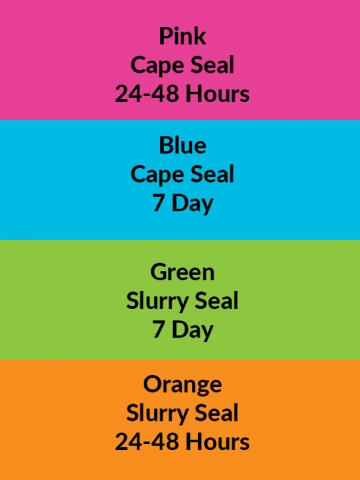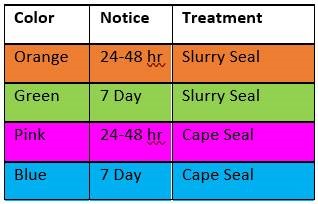Summer Road Preservation FAQs
Option A: Maps Online
Step 1: Click on the link
2024 Preservation Treatment Locations
Step 2: Select the information button or “i” button next to layer

Step 3: Zoom into your residence
Step 4: Click on the road in front of your residence or the road you frequent for commuting. On the left of the screen next to “Treatment Type” it will display what type of treatment your road is receiving.
Option B: Door hanger

Option C: Letter
Did you receive a letter in the mail? If so, please refer to the letter for more information indicating what type of treatment your road will receive.
Option D: Call or email customer service
564.397.4944 pubwks.cservice@clark.wa.gov
Please refrain from watering your lawn, washing your vehicle, or discharging liquid of any kind 24 hours before and after treatments are scheduled.
If you are disabled and need to access your vehicle and the street the day road work is occurring please contact customer service, preferably days in advance, and we can try and accommodate your needs.
564.397.4944
There is no possible way to apply a slurry seal and maintain vehicular access to driveways. We try to ease the burden by treating only a few streets at a time. If you don’t plan to leave your home before 7 a.m. on the day your street will be treated and you need to use your vehicle later in the day, please park your vehicle on an adjacent street that is not designated as a “No Parking” zone. You will be able to walk a short distance to your vehicle and drive out of your neighborhood. The same applies when you return home, unless the roads have been reopened.
If your street gets delayed it will be rescheduled, and the contractor will distribute updated notifications. This may take a few days depending on the reason for delay.
All areas outside of the asphalt pavement surface will remain open. It might be possible for you to maneuver from your residence to your parked vehicle along the curb if your street has no sidewalks.
The slurry seal treatment is not failing. As more and more vehicles maneuver on the application, sand contained in the slurry material is released from the surface due to lack of adhesion, this is especially noticeable in cul-de-sacs. Clark County is anticipating this to occur and the contractor will be coming back to sweep the slurry sealed streets after project completion.
Residents should put out their garbage and recycling as usual. Clark County and the contractor have attempted to scheduled treatments around pickup days. If there is a conflict, the contractor will be coordinating with Waste Management to ensure pickup occurs first thing.
All vehicles must be removed from the roadway before work can begin. If you have an inoperable vehicle and can move it out of the work zone, please do so. If you do not have the means to move your vehicle, please contact customer service at 564.397.4944 or pubwks.cservice@clark.wa.gov
If you believe the road work is damaged or isn’t performing as it should, you can contact customer service at 564.397.4944 or pubwks.cservice@clark.wa.gov
If you believe the Contractor has damaged your property during construction, you can contact customer service at 564.397.2446 or pubwks.cservice@clark.wa.gov
If you are expecting a delivery near the date your street is to be closed and the delivery is urgent, please make prior arrangements through your carrier for you to get your delivery on time. If your delivery is not urgent and you can wait, most carriers will try to complete the delivery again within the next few days.
Please do not drive on slurry streets before they are open. Due to the of the nature of the slurry material if you drive on a newly slurry sealed street your vehicle will be damaged, and the street will be damaged. Residents driving, walking, biking, or allowing pets on the a newly slurry sealed street will be billed for damages.
If you have an emergency call 911, an emergency will take precedence over road work.
A surface treatment applied to urban roads. This is a two-step process consisting of a chip seal followed by a slurry seal to tie everything together.
Cape seal brochure (PDF)
This surface treatment is applied to rural roads to seal the surface and prevent moisture from infiltrating the road’s subgrade. These roads are structurally sound and do not need reinforcement. Emulsified oil (.45 gallons per square yard) is applied to the road surface, followed by a covering of approximately 20 pounds of crushed rock per square yard of roadway, which is firmly pressed into the surface without further breaking the rock, or chip. The size of the rock, or aggregate, depends on the location of the road and whether a rougher surface is desired for additional traction during inclement weather. The road is closed during treatment, but traffic is usually allowed to return a few minutes after the work is completed.
Chip seal brochure (PDF)
This surface treatment is applied to urban roads to prevent moisture from infiltration to the road’s subgrade. These roads are structurally sound and do not need reinforcement. Emulsified oil, crushed aggregate and a curing compound are premixed on a truck and then applied to the road surface. This treatment requires the road to be closed for a minimum of 4 hours, depending on weather conditions, to allow curing before it can reopen to traffic.
Slurry seal brochure (PDF)
This surface treatment is for structural reinforcement on arterial and collector roads in both urban and rural areas. The depth of an overlay is between 2 and 3 inches. Surface defects and irregularities are repaired prior to adding a new layer of asphalt. In some instances, a thin lift (a 1 inch layer of asphalt) is applied to subdivision or access roads that have surface irregularities but remain structurally sound. This smooths the surface and corrects some drainage issues. During the overlay process, there are delays to the traveling public.
Asphalt overlay brochure (PDF)
A road that requires full depth reclamation, also called base stabilization, is rough and uneven and needs major structural repair. The existing surface is ground up, and cement is added and mixed to create a new base for the road. The road is then graded, reshaped and rolled, followed by a surface treatment, which can be anything from a chip seal to an asphalt overlay. There are significant motorist delays during this process.
Generally, work will begin at 7 a.m. and the streets will open by 5 p.m. However, the answer also depends on what type of treatment your road is receiving. If you do not know what type of treatment your road is receiving please refer to the first question on this page. Otherwise, follow one of links below.
Cape seal brochure (PDF)
Chip seal brochure (PDF)
Slurry seal brochure (PDF)
Asphalt overlay brochure (PDF)
Each neighborhood is treated in sections to allow parking and access in and out. Do not park on any street designated as a “No Parking” zone. Your vehicle will be towed at your expense. Please park only on streets that allow legal parking before the application.
The cone is there to remind residents that the road work is not complete, and the street is still closed to traffic of any kind.
When work doesn’t occur on the day it was scheduled it could be for a few reasons:
- It’s raining or pavement is moist enough that the material won’t bond to the surface.
- The temperature forecast is not warm enough to allow for the material to cure in time for roads to be reopened by 5 p.m.
- An equipment breakdown or other unforeseen disruption has prevented the contractor from staying on schedule.
Sidewalks will remain open, in fact, all areas outside of the asphalt pavement will remain open.
